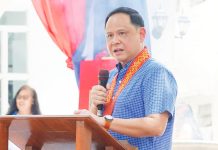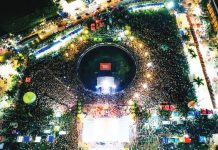
THE NUMBER of sea-based Overseas Absentee Voters (OAVs) is continuously declining. Only 12,030 registered for the 2025 midterm election.
The OAV was passed in 2003 allowing Filipinos overseas to vote for who they want to be president, vice president, senators, and party-list representatives. For the midterm elections, they will be voting for national candidates only, 12 senators and one party-list group.
Data from the Commission on Elections (Comelec) shows a 26.84 percent decrease in the number of registered OAV from 1.6 million in 2022 to 1.2 million this year.
Out of the 1,253,720 who have registered to be OAVs, 1,241,690 are land-based while the remaining 12,030 are seafarers.
Out of the 1.6 million registered OFW voters in 2022, only 626,576 voted, translating to a 38.61% voter turnout.
The large numbers of land-based OAVs this year are in the Middle East and Africa (36.5 percent), followed by Asia Pacific (30.9 percent), North and Latin America (20.9 percent), and Europe (11.7 percent).
Comelec Chairman George Garcia earlier said in an interview that Filipinos abroad are more inclined to participate in the presidential and vice-presidential election.
The overseas voting period started on April 13, 2025 and ran until May 12, 7 p.m. (Philippine Standard Time).
Comelec records show that 12,030 seafarers have registered under OAV for the 2025 election, showing a decreasing number of sea-based OAVs from 49,339 in 2016, 43,033 in 2019 and 19,584 in 2022.
In 2024, the Department of Migrant Workers (DMW) reported that there are 2,474,1972 overseas Filipino workers (OFWs) wherein 1,970,140 are land-based (378,444 new hires 1,591,696 rehires) and 504,057 are sea-based
In terms of 2024 total remittances amounting to $34,492,616,000, the sea-based sector sent home $6,941,085.000, or almost 20 percent, while the land-based sector sent home $27,551,532,000.
Seafarers may cast their ballots within 60 days before the day of elections through two modes: adopting personal voting or, in case of postal voting, in any post with international seaports as identified and recommended by the Department of Foreign Affairs.
But the strength of the seafarers’ votes is essentially felt through their families residing in the Philippines.
The votes of the OFWs, both land-based and sea-based, are courted by groups aiming to have political seats through the party-list representation.
In the recent midterm elections, around 156 groups vied for 63 seats allotted for the party-list in the House of Representatives, with 42 newly accredited party-lists included.
The party-list system was introduced in the 1987 Constitution and Republic Act 7941 (the Party-List Law) to provide a balance for locality-based lawmakers who are almost always elected on the basis of their popularity and the money that they release.
The Constitution allots 20 percent Lower House membership for party-list nominees, wherein a party-list that receives at least 2 percent of the national vote is entitled to one seat in Congress, with an extra seat given for every additional 2 percent gained, capped at a maximum of three seats.
It is a proportional representation system to favor single-issue parties, and to allow underrepresented sectors to represent themselves in the law-making process.
It was originally envisioned to focus on underrepresented community sectors or groups, including labor, peasant, urban poor, indigenous cultural, women, youth, and other such sectors as may be defined by law (except the religious sector).
However, its application changed when the Supreme Court issued a 2013 clarificatory decision noting that the party-list is a system of proportional representation open to various kinds of groups and parties, and not an exercise exclusive to marginalized sectors.
However, political dynasties have “hijacked” the party-list system with recycled lists of people already in power.
According to election watchdog Kontra Daya, the party-list system has instead been “weaponized to further marginalize the already marginalized.”
Kontra Daya has flagged 86 party-list groups for being linked to political clans, big businesses or the police/military, pork barrel/plunder/graft and corruption; dubious advocacy; and not enough information.
Although it is the party-list organization as a whole that should be evaluated by the electorate, it cannot be denied that the identity of the nominees remains a significant reference for voters without actually knowing it or its platform.
“The party list system is an attempt to introduce a new system of politics in our country, one where voters choose platforms and principles primarily and candidate-nominees secondarily,” said Supreme Court Senior Associate Justice Marvic Leonen in the 2013 case of Atong Paglaum, Inc. v. COMELEC (707 Phil. 454).
***
Atty. Dennis R. Gorecho is a Junior Partner who heads the seafarers division of the Sapalo Velez Bundang Bulilan Law Offices. For comments, e-mail info@sapalovelez.com, or call 09088665786./PN







